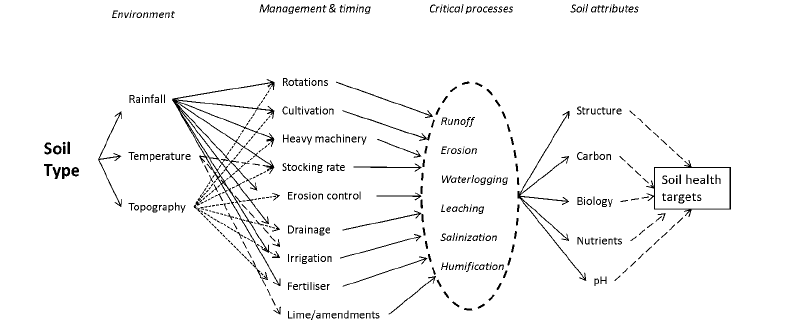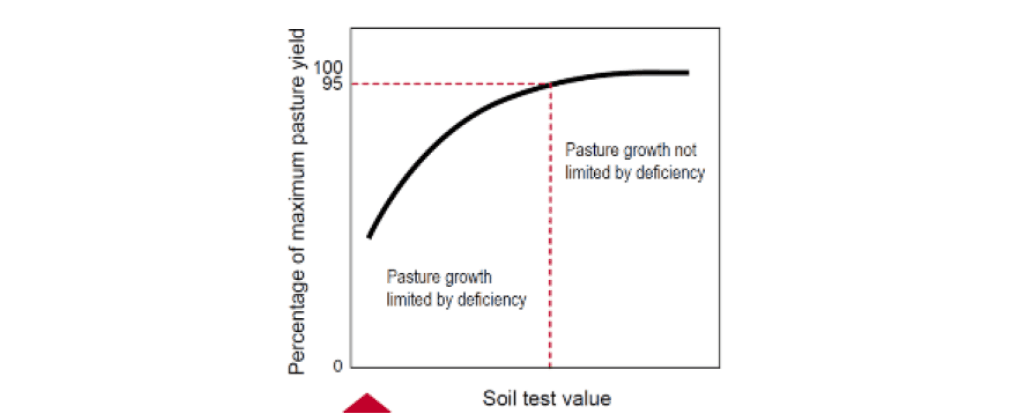- A soil needs to be fit for purpose.
- A deficiency in any one of the essential plant nutrients will reduce growth and production, even though the others may be abundantly available.
- A nutrient budget and interpretation of soil test results are the two main components of a fertiliser management plan.
- Best practice fertiliser use is about right product, right rate, right time and in the right place.
- Even if all nutrients are available in the rootzone, poor soil conditions such as compaction, water logging or salinity can impact negatively on nutrient uptake.
Key Points
Background
What is a healthy soil? A few years ago, I thought I knew the answers. However, today I realise we all have a different view and focus for our soil requirements. A soil needs to be fit for purpose and this book is about soils being fit for productive agriculture in Tasmania.
The primary goal of soil health is to conserve the soil in place, and this means preventing erosion and in the case of peat soils, preventing peat fires. A secondary goal of soil health is to support productive use whether this be agriculture, forestry or recreation. In Tasmania, soils are also used for conservation and these wilderness areas do not have a productive use but they are invaluable for ecosystem conservation.
The productive use of soil leads to four soil health requirements:
- Water supply and storage
- Organic matter in equilibrium
- Biological activity is enhanced
- Nutrient fertility is balanced
All of these requirements are interrelated (Figure 1) but I want to emphasise that although there is a lot of current focus on soil biology, we must not forget other soil basics such as soil structure and compaction. My first book, ‘Soil Health for Farming in Tasmania’ (Cotching 2009) included discussion about the first three of the above requirements and this book covers the fourth requirement for a healthy soil. Options for assessment of some key soil health indicators can be sourced in other publications (e.g. RMCG 2014).
Some native perennial silver tussock grass, kangaroo grass, or velvet tussock grass pastures in Tasmania are now protected by federal government environmental legislation (EPBC Act 1999). Applying fertiliser to native pastures can have a significant impact and may need federal approval as it can lead to a loss of native species, a decrease in the diversity of native species, and an increase in the cover of clover (Mokany et al. 2006). Details on interpreting soil test results for dryland pastures in Tasmania can be found in Palombi and Blaesing (2023).
Understanding how to manage for a healthy soil is not about quick fix solutions to soil problems and it is not about magic potions that you can buy in a bottle or bag, but rather carrying out the basics of good soil health management to optimise your soil’s health.

Figure 1. Influences on soil health
Plant Nutrients
Plant macronutrients are nitrogen (N), phosphorus (P), potassium (K), calcium (Ca), magnesium (Mg), and sulphur (S). N, P, and K are often referred to as primary nutrients and are the most common elements found in commercial fertilizers. Ca, Mg, and S are referred to as secondary nutrients and are also found in fertilizers and soil amendments. Micronutrients or trace elements, such as boron (B), copper (Cu), manganese (Mn), molybdenum (Mo), selenium (Se) and zinc (Zn) are also essential for plant growth. Macronutrients are removed in products at the rate of kilograms per tonne of product, whereas micronutrients are removed at the rate of grams per tonne of product.
A deficiency in any one of the 16 essential plant nutrients will reduce growth and production, even though the others may be abundantly available (Sinclair 1998). Optimum pasture or crop production can only be obtained if all the requirements for plant growth are met. Plant growth only occurs at the rate permitted by the most limiting factor. This fundamental principle is known as “the law of the limiting” or “Liebig’s Law of the minimum”. In organic agriculture, it is the rate of transfer from an unavailable to available nutrient form that is critical, rather than the size of the available nutrient pool (Watson 2008). If nutrients are not in the soil, they do not get there by magic, but they must be added. A list of common fertilisers and their nutrient concentrations are provided in Appendix 1, however, often fertilisers are applied as blends of varying proportions of these basic ingredients. Getting the soil nutrient levels in the optimum range is no easy task, particularly in light of different nutrients being used at different rates, each nutrient behaves differently in different soil types, and fertiliser histories are highly variable. A study in Tasmania found that only 63 of the 1698 paddocks tested (3.7%) on dairy farms had nutrient levels in the optimum range for all of the four macro nutrient measures of pH, Olsen P, extractable K and S (Cotching et al.2017).
Nutrients are transported through the soil and into plants in solution, i.e. they need water to work. Plants don't eat, they drink. Plants drink, but they can't swim, i.e. if your soil is waterlogged, no amount of fertiliser will fix a lack of drainage which can be the most limiting factor to productive plant growth. At the other extreme, a 'green drought' occurs when poor irrigation scheduling leads to soil water deficits and the application of irrigation water only keeps the grass green, but doesn't result in optimum pasture growth rates. Pasture growth rates can be cut in half, from over 80 kg DM/ha/day to approximately 40 kg DM/ha/day, despite adequate irrigation water being applied to satisfy daily evapotranspiration demand (James Hills pers comm). The decline in grass growth is due to the soil moisture being held in the soil at too high tensions to be readily available for plant use. In other words, there may be constraints to plant growth other than availability of nutrients. Soil conditions, especially soil structure and topsoil depth can have a major influence on nutrient uptake by plants.
The response of improved pastures to soil nutrient levels has been determined by trials and calibrations that define the relationship between production and soil test value as shown in Figure 2 (Gourley et al. 2007). Similar calibrations have been done for broad acre crops. The relationship allows users to predict the production response if the soil nutrient level is altered by the addition of fertiliser when no restriction to nutrient uptake apply. The response curve should be interpreted with supplementary knowledge of how local Tasmanian soils and production systems respond as there is a certain amount of 'noise' around this idealised response curve that includes pasture data from across Australia.

Figure 2. Interpretation of soil nutrient response curve in conventional agriculture (Gourley et al. 2007).
The sufficiency level of available nutrients concept is used in analysis of soil test results for conventional farming, where short-term nutrient availability is the primary concern and yields are often higher than they would be expected in organic farming. The base cation saturation ratio concept (BCSR) is sometimes used in analysis of soil test results for organic or ‘biological’ farmers. The BCSR concept states that optimal plant growth will only occur in ‘balanced’ soils with ‘ideal’ base cation ratios (Albrecht 1941). However, Albrecht’s work was confounded by changes in pH that he did not recognise. He failed to realise that plant growth is limited in acidic soils and additions of calcium alone will not improve soil pH levels (Kelling et al. 1996; Schonbeck 2000). The data available today does not support the claims of the BCSR concept and a soil’s chemical, physical and biological fertility cannot be linked to nutrient ratios (Kopittke & Menzies 2007). Plants are able to thrive over a range of cation ratios if the nutrients are provided in a suitable amount (Johnston 2011). However, the balance between soil nutrients, particularly the cations (positively charged ions) such as potassium, calcium and magnesium and sodium where it occurs at elevated levels, is of importance. Too much potassium can induce deficiencies of other cations, particularly magnesium, which can result in animal health issues, e.g. grass tetany and milk fever. Potassium deficiency may occur in soils which seem to have adequate potassium, if the soil calcium and magnesium levels are also high. Potassium deficiency can also occur in some heavier soils when plant requirements exceed potassium desorption from clay minerals. The happens during accelerated fast growth, for instance in potato and poppy crops (i.e. tuber and above ground growth/flowering and running up respectively).
Right product, right rate, right time, right place
Best practice fertiliser use is about applying the right product, at the right rate, at the right time and in the right place, in order to achieve maximum productivity while avoiding adverse environmental impacts. (International 4R Nutrient Stewardship concept for fertiliser best management practices). The Australian fertiliser industry’s Fertcare® accreditation program is in alignment with the 4R concept
(Fertiliser Australia 2022).
The 4R Nutrient Stewardship concept can be summarised as (Roberts 2007):
Match the fertiliser source and product to crop need and soil properties. Be aware of nutrient interactions and balance nitrogen, phosphorus, potassium, and other nutrients according to soil analysis and crop needs.
Match the amount of fertiliser applied to the crop needs. Too much fertiliser leads to leaching and other losses to the environment and too little results in lower yields and crop quality. Realistic yield goals, soil testing, nutrient budgets, tissue testing, plant analysis, applicator calibration, variable rate technology, crop scouting and good record keeping are BMPs that will help determine the right rate of fertiliser to apply.
The timing of nutrient applications is critical to achieve optimum plant growth and to minimise runoff of nutrients to the environment. Make nutrients available when the crop needs them. Application timing (pre-plant or split applications), controlled release technologies, stabilisers and inhibitors are examples of BMPs that influence the timing of nutrient availability.
Place and keep nutrients where crops can use them. Application method is critical for efficient fertiliser use. Crop, cropping system, and soil properties dictate the most appropriate method of application, but incorporation is usually the best option to keep nutrients in place and increase their efficiency.
A fertiliser management plan
There are two main components to prepare a fertiliser management plan: A nutrient budget (Chapter 2) and interpretation of soil test results (Chapter 3).
My soil fertility management checklist includes the following:
- How often do you soil test?
- Do you know what the optimum ranges for soil pH and nutrients are?
- Are soil nutrient values different on different parts of your farm?
- Is a nutrient budget (inputs and outputs) part of your fertiliser planning?
- How often do you review your fertiliser plan, or do you apply the same product at the same rate to the same crop each year?
- Do your livestock suffer from any metabolic disorders, such as grass staggers (tetany), when blood magnesium levels fall below a critical level, from one month before to two months after calving, or nitrate poisoning, e.g. on lush pastures during overcast conditions?
